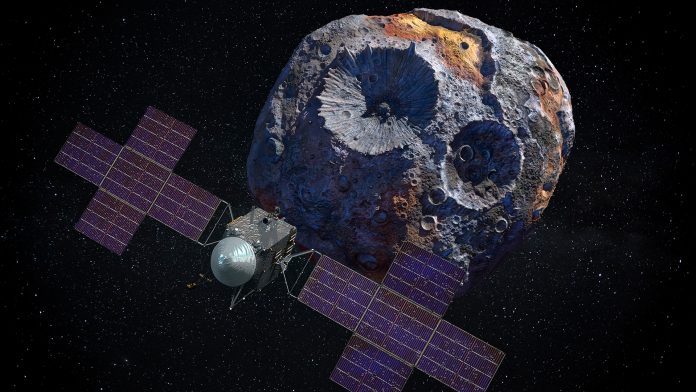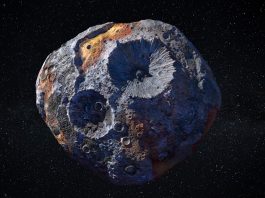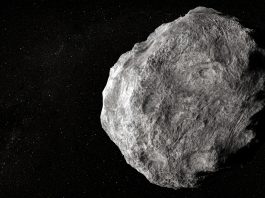A team of astronomers have analysed millimetre-wavelength emissions of the Psyche asteroid to produce the first-ever temperature map of the celestial body’s surface.
The investigation, led by scientists from the California Institute of Technology (Caltech) and Bloomsburg University, utilised Chile’s Atacama Large Millimeter/submillimeter Array (ALMA), obtaining unprecedented insights into the enigmatic properties of the Psyche asteroid.
As interstellar objects go, the Psyche asteroid is one of the most mysterious that scientists have encountered in our solar system, so much so that NASA is planning to visit the space rock in 2026, with many scientists hypothesising that the asteroid is the remnants of a protoplanet’s core.
The research is published in the Planetary Science Journal (PSJ).
Origins of the Psyche asteroid
The Psyche asteroid is situated in the asteroid belt orbiting the Sun; the asteroid belt is a doughnut-shaped area of Space between the Earth and Jupiter that is comprised of over one million rocky bodies that vary in size, from 10 metres to 946 kilometres in diameter.
With a diameter in excess of 200km, the Psyche asteroid is the largest M-Type asteroid located in the solar system – a mysterious classification of asteroids that are believed to be rich in metal, which infers that they are potentially fragments of the cores of protoplanets which were broken apart in the early formation of the solar system.
Katherine de Kleer, an assistant professor of planetary science and astronomy and lead author of the study, said: “The early solar system was a violent place, as planetary bodies coalesced and then collided with one another while settling into orbits around the Sun. We think that fragments of the cores, mantles, and crusts of these objects remain today in the form of asteroids. If that’s true, it gives us our only real opportunity to directly study the cores of planet-like objects.”
Novel methods of examination
Conventional methods of studying cosmic objects like the Psyche asteroid have so far yielded inaccuracies, this being due to analysing relatively small objects at far distances being extremely challenging, with Psyche’s distance from Earth ranging from 179.5 to 329 million kilometres. Traditional approaches, such as thermal observation from Earth, measures in infrared wavelengths the light emitted by an object instead of the light it reflects from the Sun. However, this technique can only obtain one-pixel images of asteroids, which doesn’t reveal many details of the object, such as its thermal inertia, how fast it heats up to sunlight, and cooled by darkness.
Saverio Cambioni, a postdoctoral scholar in planetary science at Caltech and co-author of the study, said: “Low thermal inertia is typically associated with layers of dust, while high thermal inertia may indicate rocks on the surface. However, discerning one type of landscape from the other is difficult. Data from viewing each surface location at many times of day provide much more detail, leading to an interpretation that is subject to less ambiguity and which provide a more reliable prediction of landscape type prior to a spacecraft’s arrival.”
To provide a more comprehensive understanding of the Psyche asteroid, the team employed the use of ALMA in Chile – a radio array of 66 telescopes that allowed them to map the thermal emissions accurately at a resolution of 30 kilometres – which created an image of the asteroid’s composition of around 50 pixels. Alma enabled the astronomers to observe Psyche at millimetre-wavelengths that are much longer (between one to ten millimetres) than infrared wavelengths (usually five to 30 microns).
The findings from the analysis revealed that the thermal inertia of the Psyche asteroid is high in comparison to a typical asteroid, which indicates that it has an unusually dense or conductive surface. Additionally, the researchers discovered that the amount of heat it radiates – its thermal emission – is only 60% of what would be expected from a surface with that amount of thermal inertia. Due to the surface-emission being affected by the presence of metal on the surface, this signifies that the surface of Psyche is no less than 30% metal. Subsequently, the team conducted an analysis of the polarisation of the emission to calculate the form of the metal; a smooth solid surface will emit well-organised, polarised light. However, Psyche’s light was scattered, suggesting that the rocks on the surface are inundated with metallic grains.
Katherine de Kleer: “We’ve known for many years that objects in this class are not, in fact, solid metal, but what they are and how they formed is still an enigma. The findings reinforce alternative proposals for Psyche’s surface composition, including that Psyche could be a primitive asteroid that formed closer to the Sun than it is today instead of a core of a fragmented protoplanet.”
The techniques utilised in this study have attained unprecedented insights into asteroid surface compositions. The astronomers now aim to apply these methods to study other large objects in the asteroid belt.









